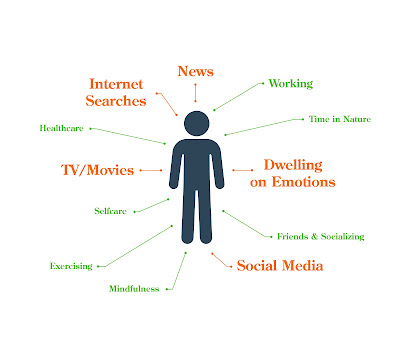by Dr. Iva Lloyd, ND
It is always a good idea to check in every now and then to determine if your focus and actions are aligned with goals and desires. Many people desire to be healthy, for example, but they actually spend very little time on activities that support health.One thing is true, everyone has the same amount of time - 24-hours in a day, 7-days in a week. Being able to see the connection between what you do and where you are in life is a worthwhile exercise and can help you live more consciously.
Step 1: List of Roles and Activities
The first thing to do is make a list of all the things that you do and the roles that you have in life. Most people are surprised at the number of activities and roles that they do on a daily or weekly basis. Some examples are:
Roles:
- mother or father
- sister or brother
- aunt, uncle or cousin
- friend
- student or co-worker
- volunteer
- community work
- etc. etc.
Activities:
- self-care
- exercising
- food preparation and eating
- working
- sleeping
- mindfulness and meditation
- social media
- web searching or watching television / movies
- spending time in nature
- healthcare
- reading
- hobby or project
- spending or saving money
- etc. etc.
Step 2: Current Satisfaction Level
The 2nd step is to take some time and assess how satisfied you are with your life. How much joy and happiness do you experience. Are you healthy and fit? How are you handling the ups and downs of life? What are your goals and your plans? Do you have health concerns that you need to address? Where are you financially? How is the external stress of life affecting you? Are there external factors that may impact your life and are you ready for them?
Spending time to reflect is an important aspect of life. As we all know, there are aspects of life that are not within our control and it is important to reflect on how they have impacted us and in what ways have they affected our life and our choices. If your aim is to live life more consciously, than it is important to spend time reflecting on what you do and whether it matches with who you want to be. Living consciously also helps to adjust and accommodate the stressors of life that cross our path.
Step 3: Mapping of Activities and Goals
Once you have an idea of what aspects of your life are working for you and which aren't, the third step is to look at how much time you are spending in each aspect and to determine what needs to change. The aim is to decide what activities you need to increase and which ones you need to decrease. For some activities, it may be about changing how you are doing them. For example, you might find that you still want to make exercise an important aspect of your life, but you are going to spend more time exercising outside and focusing on cardiovascular versus doing weight training in a gym.
We change and our life changes when we make conscious choices to do something differently. It can help to:
- Keep in mind that you only have 24 hours in a day; 7 days in a week.
- Recognize that if you are overwhelmed then you likely have too many things on your plate and it would be helpful to look at those activities you can decrease or remove.
- Whatever you focus on increases in intensity and importance. Living consciously is about being more aware of your choices and choosing more intentionally.
Step 4: Make Strategic Changes
Once you have decided what needs to change, start making the changes one at a time. Generally, it is not about changing everything at once. It is about starting slowly and moving forward in the direction you want. It is always helpful to check in on a weekly or monthly basis with your plans to ensure that you stay on track. If you struggle with staying true to your goals, it may help to work with someone else - a naturopathic doctor, nutritionist, personal trainer, etc. - to support the specific changes that you desire.
Other blogs that you may find helpful:



